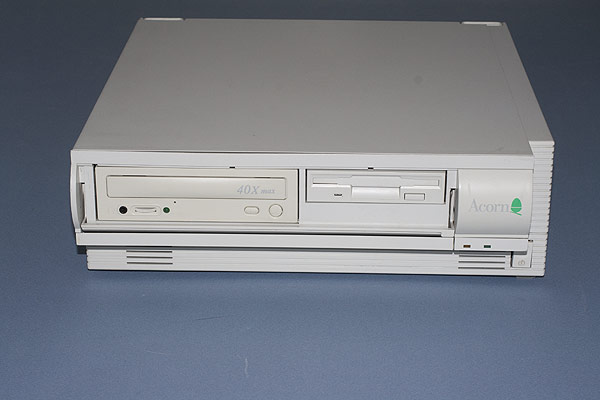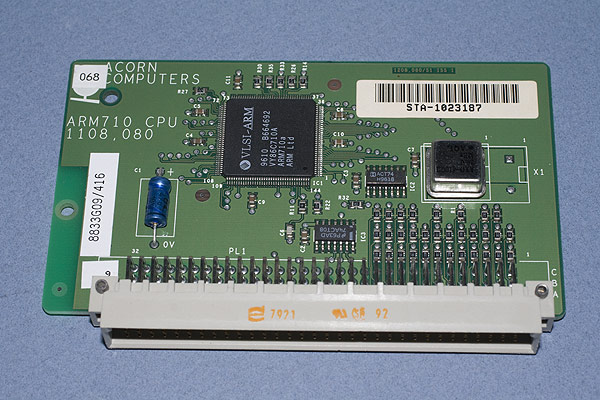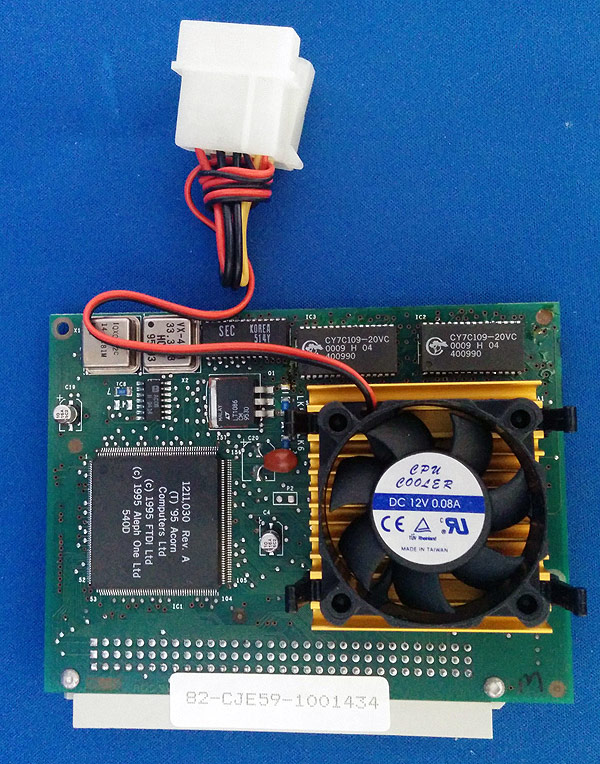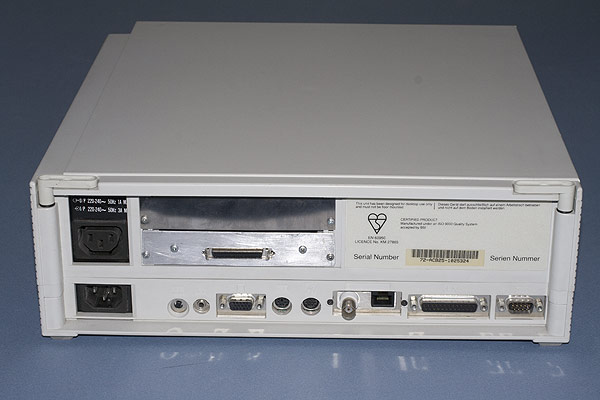The Acorn RiscPC
The Acorn RiscPC was effectively the last major production computer released by Acorn. It featured many of the original design concepts that were inherent to the BBC Micro and the Archimedes computers that went before it but was more refined than any of its predecessors.

Initially launched in April 1994 badged as the RiscPC 600, it sported the new ARM6 processor running at 30Mhz on a daughterboard which would allow for the processor to be upgraded quickly an easily as technology improved.

Sure enough, a year after the RiscPC 600 was introduced, the RiscPC 700 was launched and the ARM7 CPU that shipped within was also sold as an upgrade to the now year old RiscPC 600.
I have both the ARM610, ARM710 and a StrongARM processor board and for the most part, I use the StrongARM processor as it is significantly faster than the both the ARM6 and ARM7 CPU's making the machine more usable. In terms of usability, the RiscPC and a StrongARM processor is very much still a usable computer for day to day activities and at the time of writing (Feb 2016), there are still many people that use them as their day to day computer (albeit with third party upgrades to improve performance of the video and CPU).

The RiscPC re-introduced the concept of a second processor much akin to the second processor that you could connect to the BBC Micro via the Tube interface. In common with the Tube interface, you could technically hang pretty much any CPU off of the RiscPC's second processor slot and in order to compete with the growing "Wintel" IBM PC compatible market at the time, Acorn released 486 processor boards allowing you to run Microsoft Windows natively on an x86 processor within a window on the RISC OS desktop or "Full screen" as a dedicated IBM PC compatible machine. CJE Micros later took an AMD 5x86 which was the fastest ever 486 architecture processor and added several components to the Acorn 486 boards to provide the equivalent x86 performance of a Pentium 75 in the RiscPC.

Architecturally, the Risc PC was groundbreaking in many areas however the front side bus and expansion slots ran significantly slower than the IBM PC compatible's PCI technology which was available at the time. This design point of the RiscPC was widely regarded as a serious bottleneck in the RiscPC's performance especially when the faster StrongARM processors were released.

Production of the RiscPC only ceased in 2003, several years after Acorn's own demise and the RiscPC had moved on from the original StrongARM processor upgrade to the Kinetic CPU card which worked around the limitations of the RiscPC bus by placing the memory used by the CPU on the Kinetic CPU card itself allowing for a faster CPU <-> RAM bus. the podule bus however was still restricted by the original RiscPC architecture.
Expansions in this RiscPC
- StrongARM CPU daughterboard @ 200MHz
- 2 x 128MB FPM SIMMs
- CJE Micros 5x86 133MHz 512K - PC card
- RISC OS 4.39 ROMs
- i-Cubed EtherLAN 600
- 2MB VRAM module
- 16-bit Audio upgrade
- Irlam Instruments i16 sound sampler
- Castle Technologies 10/100baseT Ethernet card
- Power-tec SCSI II Host adapter controller with SCSI2SD v5.0 card
- Second case slice and case pins
Repair/Change History
I bought my RiscPC from the Wakefield Show in 2013 in fully working condition. At the time its had just 16MB of RAM, 1MB VRAM, 8-bit audio and no network card so these issues were addressed by fitting 256MB of RAM, a 2MB VRAM module, the Acorn 16-bit audio upgrade and an i-Cubed EtherLAN 600 10 base T network card.
At some point in the machines history, it had been upgraded from the original RISC OS 3.5 which shipped with the RiscPC 600 to RISC OS 4 which was produced by RISC OS Ltd after Acorn Computers ceased trading. The re-chargeable CMOS battery that was originally fitted to the RiscPC had also been removed and replaced with a rather elegant home-made coin cell battery with a diode/resistor combination to prevent charging. The battery was replaced last in March 2019.
In July 2014, I fitted the CJE Micros 5x86 PC Card and installed Microsoft Windows 95 on a virtual hard drive. I configured the i-Cubed network card to enable its Virtual NIC thereby allowing Windows 95 to access the Internet directly from the RiscPC.
In August 2014, I fitted two 128MB FPM SIMMs to take the memory to 256MB with 2MB VRAM. This allowed me to use the Select 3i3 that was installed on the hard drive to be used as it takes 6MB of RAM for the soft loaded ROMs. Having the extra memory also allows the 5x86 PC card to run with as much memory as possible (32MB) and still leave plenty of RAM for applications within RISC OS itself.
In February 2016, a StrongARM 200MHz CPU was fitted to the machine providing a significant performance increase.
In May 2016, a second slice and set of pins was aquired to allow for further expansion.
In March 2019, an Irlam Instruments i16 sound sampler and Castle Technologies 10/100 Ethernet card were fitted to the machine and RISC OS 4.39 ROMs were fitted in April 2019, replacing the RISC OS 4.02 ROMs and soft loaded RISC OS 4.37.
Translate this site
Acorn Kit
IconBar posts
News
- RISC OS continues to grow on GitHub
- Archive magazine updates
- Wakefield 2022 will go ahead on Saturday 21st May
- Drag'n'Drop 11i2 edition reviewed
- RISCOSbits releases some more risque hardware
Forums
- RISCOSbits releases some more risque hardware
- Is BASIC still useful for coding?
- Is BASIC still useful for coding?
- Three RISC OS Show dates for your 2022 diary
- Iris Web Browser receives January update
provided courtesy of The IconBar
RISC OS Rambles
Articles covering a range of topics all about the development of RISC OS from one of its developers Justin Fletcher. Well worth the read!
JASSP Forums
The JASSP project run by Jon Abbott is an attempt to acquire the rights to all of the Acorn Archimedes games back catalogue and archive them for the future.
Archiving the games is just half of the battle. Jon has written ADFFS which allows those archived images to be loaded and played on any ARM based machine running RISC OS which involves patching these games to run on later hardware using a JIT/VM style environment within ADFFS to allow the games to be patched to run safely on the latest hardware.
- ADFFS • Re: ADFFS 2.80 public beta
- ADFFS • Re: ADFFS 2.80 public beta
- ADFFS • Re: ADFFS 2.80 public beta
- ADFFS • Re: ADFFS 2.80 public beta
- ADFFS • Re: ADFFS 2.80 public beta
- General • Re: Help playing games
- General • Help playing games
- ADFFS • Re: ADFFS 2.80 public beta
- ADFFS • Re: ADFFS 2.80 public beta
- ADFFS • Re: ADFFS 2.80 public beta
- ADFFS • Re: ADFFS 2.80 public beta
- General • Re: Virtual Golf
- ADFFS • Re: ADFFS 2.80 public beta
- General • Re: Virtual Golf
- ADFFS • Re: ADFFS 2.80 public beta